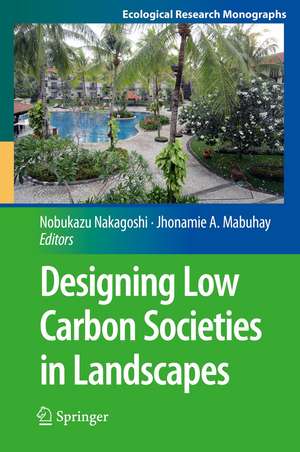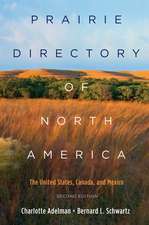Designing Low Carbon Societies in Landscapes: Ecological Research Monographs
Editat de Nobukazu Nakagoshi, Jhonamie A. Mabuhayen Limba Engleză Hardback – 20 mai 2014
As a result of global warming, abnormal weather phenomena including super typhoons have occurred frequently in recent years. The major underlying cause is the higher concentration of greenhouse gases released by human activities. As well, major natural absorbers of CO2 such as forests, wetlands, and coral reefs are shrinking, and the human impact is causing the ecological balance to deteriorate. Controlling CO2 emissions and expanding the CO2 absorbers are keys to reducing total CO2. Low carbon societies can be established by maintaining the original CO2 balance through integration of multiple tools, with contributions from diverse fields such as physics and chemistry, physiology and humanities, and education. On the basis of an international consensus, the environment must be protected no matter what sacrifices are required. As this book demonstrates, achieving a low carbon society is a top priority, and landscape conservation is the first step in ecological researchtoward that goal.
| Toate formatele și edițiile | Preț | Express |
|---|---|---|
| Paperback (1) | 1220.12 lei 6-8 săpt. | |
| Springer – 23 aug 2016 | 1220.12 lei 6-8 săpt. | |
| Hardback (1) | 1231.47 lei 6-8 săpt. | |
| Springer – 20 mai 2014 | 1231.47 lei 6-8 săpt. |
Din seria Ecological Research Monographs
- 18%
 Preț: 892.90 lei
Preț: 892.90 lei - 18%
 Preț: 947.50 lei
Preț: 947.50 lei - 15%
 Preț: 641.53 lei
Preț: 641.53 lei - 18%
 Preț: 1119.87 lei
Preț: 1119.87 lei - 18%
 Preț: 1235.08 lei
Preț: 1235.08 lei - 18%
 Preț: 1114.21 lei
Preț: 1114.21 lei - 18%
 Preț: 1123.35 lei
Preț: 1123.35 lei - 24%
 Preț: 772.24 lei
Preț: 772.24 lei - 24%
 Preț: 836.70 lei
Preț: 836.70 lei - 24%
 Preț: 833.35 lei
Preț: 833.35 lei - 18%
 Preț: 1116.26 lei
Preț: 1116.26 lei - 18%
 Preț: 1003.24 lei
Preț: 1003.24 lei - 15%
 Preț: 706.63 lei
Preț: 706.63 lei - 18%
 Preț: 1382.83 lei
Preț: 1382.83 lei - 15%
 Preț: 635.15 lei
Preț: 635.15 lei - 18%
 Preț: 937.09 lei
Preț: 937.09 lei - 18%
 Preț: 957.62 lei
Preț: 957.62 lei - 18%
 Preț: 946.55 lei
Preț: 946.55 lei - 15%
 Preț: 651.99 lei
Preț: 651.99 lei - 18%
 Preț: 964.71 lei
Preț: 964.71 lei - 20%
 Preț: 573.21 lei
Preț: 573.21 lei - 24%
 Preț: 938.23 lei
Preț: 938.23 lei -
 Preț: 362.99 lei
Preț: 362.99 lei -
 Preț: 328.42 lei
Preț: 328.42 lei - 24%
 Preț: 903.49 lei
Preț: 903.49 lei - 24%
 Preț: 1231.53 lei
Preț: 1231.53 lei
Preț: 1231.47 lei
Preț vechi: 1501.79 lei
-18% Nou
Puncte Express: 1847
Preț estimativ în valută:
235.67€ • 245.14$ • 194.56£
235.67€ • 245.14$ • 194.56£
Carte tipărită la comandă
Livrare economică 14-28 aprilie
Preluare comenzi: 021 569.72.76
Specificații
ISBN-13: 9784431548188
ISBN-10: 4431548181
Pagini: 368
Ilustrații: XI, 353 p. 111 illus., 23 illus. in color.
Dimensiuni: 155 x 235 x 25 mm
Greutate: 0.84 kg
Ediția:2014
Editura: Springer
Colecția Springer
Seria Ecological Research Monographs
Locul publicării:Tokyo, Japan
ISBN-10: 4431548181
Pagini: 368
Ilustrații: XI, 353 p. 111 illus., 23 illus. in color.
Dimensiuni: 155 x 235 x 25 mm
Greutate: 0.84 kg
Ediția:2014
Editura: Springer
Colecția Springer
Seria Ecological Research Monographs
Locul publicării:Tokyo, Japan
Public țintă
ResearchCuprins
Part I. Introduction.- 1. Landscape Ecological Approaches to Low-Carbon Society.- Part II. Urban Landscape Ecology.- 2. Cooling potential of urban green spaces in summer.- 3. Is Ecotopia Possible? A few Proposals for Urban Ecology.- 4. Transpiration characteristics of Chinese pines (Pinus tabulaeformis) in an urban environment.- 5. Landscape design for urban biodiversity and ecological education in Yomiya park, Kitakyushu-city, Japan : Approaching from Multi Functional Landscape Planning.- Part III. Ecologies on Cultural Landscapes.- 6. Can Satoyama Offer a Realistic Solution for a Low Carbon Society? Public Perception and Challenges Arising.- 7. Effects of Sustainable Energy Facilities on Landscape: A Case Study of Slovakia.- 8. Low Carbon Society through Pekarangan Traditional Agroforestry Practices in Java, Indonesia.- 9. Challenges and Goal of Sustainable Island: Case Study in UNESCO Shinan Dadohae Biosphere Reserve, Korea.- 10. The neglect of traditional ecological knowledge on the wild elephant-related problems in Xishuangbanna, SW China.- 11. Effects of Tropical Successional Forests on Bird Feeding Guilds.- Part IV. Ecologies on Protected Areas.- 12. Understanding development trends and landscape changes of protected areas in peninsular Malaysia: a much needed component of sustainable conservation planning.- 13. Land Use Trends Analysis Using SPOT 5 Images and Its Effect on the Landscape of Cameron Highlands, Malaysia.- 14. The Relationship between land use land cover and land degradation of natural protected area in Batang Merao Watershed, Indonesia.- 15. Ecotourism Activities for Sustainability and Management of Forest Protected Areas (Case of Camili Biosphere Reserve Area in Turkey).- 16. Community Aspects on Forest Ecosystems in the Gunung Gede Pangrango National Park UNESCO Biosphere Reserves, Indonesia.- 17. Landscape ecology based approach for assessing pekarangan condition to preserve protected area in West Java.-18. Integrated the Aerial Photos and DTM to Estimate the Area and Niche of Arundo formosana in Jiou-Jiou Peaks Natural Reserve of Taiwan.- 19. REDD+ readiness through selected project activities, financial mechanism and provincial perspectives in Indonesia.
Recenzii
From the book reviews:
“The book is suitable for researchers, policy makers and town planners. … the book is interesting as it ‘contains several research cases on tropical regions that had not been actively explored in the past’. Readers have the ‘option to choose their favourite chapters according to their individual interests in landscapes’.” (P. C. Abhilash, Journal of Cleaner Production, Vol. 87, 2015)
“The book is suitable for researchers, policy makers and town planners. … the book is interesting as it ‘contains several research cases on tropical regions that had not been actively explored in the past’. Readers have the ‘option to choose their favourite chapters according to their individual interests in landscapes’.” (P. C. Abhilash, Journal of Cleaner Production, Vol. 87, 2015)
Textul de pe ultima copertă
This book focuses on three major means of achieving a low carbon society: conservation of the ecosystem complex, changes of arrangement of landscapes, and creation of biodiversity. There are specific countermeasures to be taken for carbon absorption in the three types of landscapes—urban, cultural, and natural—because their carbon balances differ. Urban landscapes are promising sites because they have the potential for greening and the creation of biodiversity. Cultural landscapes in the tropics had not been actively researched until recently, but this book now presents a collection of several cases focused on those areas. Natural landscapes had existed in abundance in developing countries; later, nature protection areas were designated to coexist with development. Now, however, developmental pressure has penetrated into those nature protection areas, and landscape ecological projects are urgently required to preserve them.
As a result of global warming, abnormal weather phenomena including super typhoons have occurred frequently in recent years. The major underlying cause is the higher concentration of greenhouse gases released by human activities. As well, major natural absorbers of CO2 such as forests, wetlands, and coral reefs are shrinking, and the human impact is causing the ecological balance to deteriorate. Controlling CO2 emissions and expanding the CO2 absorbers are keys to reducing total CO2. Low carbon societies can be established by maintaining the original CO2 balance through integration of multiple tools, with contributions from diverse fields such as physics and chemistry, physiology and humanities, and education. On the basis of an international consensus, the environment must be protected no matter what sacrifices are required. As this book demonstrates, achieving a low carbon society is a top priority, and landscape conservation is the first step in ecological researchtoward that goal.
As a result of global warming, abnormal weather phenomena including super typhoons have occurred frequently in recent years. The major underlying cause is the higher concentration of greenhouse gases released by human activities. As well, major natural absorbers of CO2 such as forests, wetlands, and coral reefs are shrinking, and the human impact is causing the ecological balance to deteriorate. Controlling CO2 emissions and expanding the CO2 absorbers are keys to reducing total CO2. Low carbon societies can be established by maintaining the original CO2 balance through integration of multiple tools, with contributions from diverse fields such as physics and chemistry, physiology and humanities, and education. On the basis of an international consensus, the environment must be protected no matter what sacrifices are required. As this book demonstrates, achieving a low carbon society is a top priority, and landscape conservation is the first step in ecological researchtoward that goal.
Caracteristici
Shows readers how protecting landscapes is essential to maintaining a low carbon society Introduces feasible research outcomes for landscape planners working in nature protection areas Indicates the direction of future ecological research on low carbon society modeling Includes supplementary material: sn.pub/extras











